

|
Solo Soundclip:
|
| See Steve's Hand-Written Solo transcription |
|
Michael Brecker's
solo on: 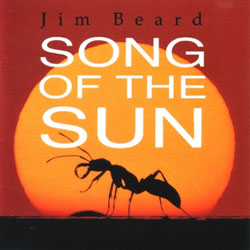 with some European musicians back in 2015 in Monaco. This piece first appeared on Jim's classic 1991 album, "SONG OF THE SUN"(CTI). But here, Jim was playing a reduced version of the song in a quartet format - and the beauty, grace and atmosphere of the composition still came shining through. This discovery caused me to revisit to the original version, which featured a monstrous tenor sax solo by Michael Brecker. Next thing I knew, I sat down and transcribed just the 1st 16 bars of the Intro, which includes some fantastic linear keyboard playing from Jim. It was revelatory for me to hear these very compact voicings creating such a sense of mood and atmosphere. These elements are always crucial to me, and they can be and should be found in all great music. with some European musicians back in 2015 in Monaco. This piece first appeared on Jim's classic 1991 album, "SONG OF THE SUN"(CTI). But here, Jim was playing a reduced version of the song in a quartet format - and the beauty, grace and atmosphere of the composition still came shining through. This discovery caused me to revisit to the original version, which featured a monstrous tenor sax solo by Michael Brecker. Next thing I knew, I sat down and transcribed just the 1st 16 bars of the Intro, which includes some fantastic linear keyboard playing from Jim. It was revelatory for me to hear these very compact voicings creating such a sense of mood and atmosphere. These elements are always crucial to me, and they can be and should be found in all great music.I e-mailed Jim my initial transcription and, after an exchange of comments, I asked him if he would kindly send me a pdf of "Baker's Annex" and Jim complied. From there my fascination grew and I began to transcribe Mike's solo - always a daunting task, knowing that I will never have the confidence to be able to complete it to my satisfaction, and that it may never be perfectly accurate. But now, here we are, and it is ready for presentation here at KHAN'S KORNER 1. Let me first say that Jim Beard's "SONG OF THE SUN" is one of the great, great albums of all time! Whether you want to categorize it as Jazz or Jazz-Fusion doesn't matter, because the music, compositions, production, audio, and the performances by a collection of brilliant players, specifically chosen for certain songs, are all stellar. To me, this is the kind of album where all the players should forever feel proud to have been a part of such a work. I can't urge you all strongly enough to find your way to going out there and buying this album in whatever format you can find it. Of course,  I would push you to find a CD and have that forever and always. The album is a collection of 11 of Jim's fantastically unique songs, all brilliantly orchestrated within a small group context. It is simply masterful. Recorded between May-June of 1990 by Phil Magnotti, "Baker's Annex" features the following collection of players: Jim Beard(Piano & Synthesizers); Michael Brecker(Tenor Sax); Jon Herington(Guitar); Anthony Jackson(Contrabass Guitar); Ben Perowsky(Drums) and Minu Cinelu(Percussion). Each player brings something magical to the end result. I would push you to find a CD and have that forever and always. The album is a collection of 11 of Jim's fantastically unique songs, all brilliantly orchestrated within a small group context. It is simply masterful. Recorded between May-June of 1990 by Phil Magnotti, "Baker's Annex" features the following collection of players: Jim Beard(Piano & Synthesizers); Michael Brecker(Tenor Sax); Jon Herington(Guitar); Anthony Jackson(Contrabass Guitar); Ben Perowsky(Drums) and Minu Cinelu(Percussion). Each player brings something magical to the end result.Jim Beard was kind enough to send me this reflection of this song and the album: "Prior to making "SONG OF THE SUN," I had been touring with Wayne Shorter for over a year and with John Scofield for several months. I feel that my immersion into Wayne's music ("ATLANTIS"), and John's writing at that time (the late '80s) made me more aware of perceiving chordal harmony as a linear/melodic process rather than a series of vertical events. I was writing every chance I got, and there was a lot of interesting, creative music being released during that time, for example "AMBITIOUS LOVERS" by Peter Scherer and Arto Lindsay, that seeped into my blood. When I was offered a record deal from Creed Taylor(CTI), he asked me who I had in mind for soloists. I mentioned my three favorite (living) players, not knowing if they would be available, or even want to take part in my recording. As it turned out, Wayne Shorter, Toots Thielemans and Michael Brecker all were free and enthusiastic about playing on it. Before recording "Baker's Annex" (named after the music school/fallout shelter building at Indiana University, and the head of the Jazz Department, David Baker), Michael wanted to sit with me at the piano and go through the solo changes one at a time. He wanted to know how I heard the tonal and linear nature of the chords. We spent about half an hour together, and during that time, he made his own notes on his chart." - Jim Beard, December, 2022 After the beautiful, mood-setting Intro, the melody for "Baker's Annex" is presented in 2 16-bar [A] sections, and then the [B] section introduces Jim's acoustic piano dancing around the principal melody. After that, we are given a terrific "bridge" section, which Jim labels as letter [C], and it is also a 16-bar section comprised of 4-bar melodic units, each stated in beautiful half-notes where Michael Brecker's tenor sax enters to play the top notes of each carefully chosen voicing. What makes this section so emotive is that you have an ascending melody coupled with a descending, in most cases, bass line. This section serves as the perfect launching pad for Mike Brecker's majestic tenor sax solo. The transition from this soaring melodic section to the solo is most ingenious on Jim's part, because the last chord of the [C] section is Bmaj9 with the voicing, spelling-down: F#-C#-B-F#. If you spelled that voicing enharmonically, you would have, spelling down: Gb-Db-Cb-Gb. And what is the 1st voicing of the solo? That same voicing over Db as the root, making it Db7(sus). But, as I like to view things, it would be Abm7sus/Db. In the end, in terms of modality, it is exactly the same thing. The solo in total is 32-bars in length and, in reality it is a 16-bar format that is repeated. As the solo ends, there is a 4-bar denouement over a reprise of the Intro changes. Leading up to writing my final version of this analysis, I was most fortunate to be able to exchange a sequence of e-mails with Jim Beard covering any number of topics and questions of mine, hoping to better understand what was going on from Jim's point-of-view. It was remarkably helpful and insightful. In the end, I'm going to offer my perspective on how I view these harmonies, and the modes or scales that they might imply to the player - in this case, to Michael Brecker. So, let me try my best and present this interpretation of what Mike played. As it is with any solo or musical improvisation, one always wants it to begin melodically and as the solo develops, for it to have been consistently within the flow of the overall piece which, of course, includes the rhythmic elements as well as the harmonic elements. Within the 1st 8 bars, Mike does exactly that, playing over an unfamiliar set of changes. If you have now read Jim's personal comments above, when I read them, it made perfect sense to me. Initially, when I saw Jim's lead sheet, the way that the chords were labeled, I wasn't sure just what they really meant, where soloing was concerned, and I needed to hear the section in order to make better sense of it. 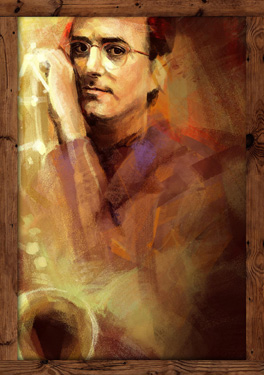 Once I had transcribed the changes, I conferred with Jim about what conclusions I had come to, and we had further great discussions and, as it turned out, we pretty much viewed the harmonic/modal implications in very similar ways. And so, as I present a portrait of what Mike played over the first 16-bars, one half, of the solo, I will also lay out the labeling of the each chord, two of them per bar, and the indicated mode or scale. With possession of that information, you can decide for yourself just how you might have approached these same harmonic challenges. Once I had transcribed the changes, I conferred with Jim about what conclusions I had come to, and we had further great discussions and, as it turned out, we pretty much viewed the harmonic/modal implications in very similar ways. And so, as I present a portrait of what Mike played over the first 16-bars, one half, of the solo, I will also lay out the labeling of the each chord, two of them per bar, and the indicated mode or scale. With possession of that information, you can decide for yourself just how you might have approached these same harmonic challenges.As always, this transcription is written in concert key, but transposed an octave up from where it sounds, as this is where one writes for the guitar. The tenor sax is actually written for one octave plus a whole-step above where it sounds. So, what you might be looking at is actually close in written register to what a tenor saxophonist actually sees. Here's hoping that this is not too confusing for those non-guitarists out there who are visiting these pages for the first time. Because the chord changes can appear to be a bit disjointed, there is always a way to hear the common tones between each center and, if possible, let those common tones glue the solo's fragments together with one another. In each case, during the solo, I tried to keep the notation consistent - and, in most cases that meant using flats(b's) as opposed to sharps(#s), but sometimes, as in bars 4 and 12, using #s became a necessity, given the chords. In bar 1, the chords move from Db7(sus) or Abm7(sus)/Db to Abmaj7(6). Over the Db7(sus) chord, I view this as Ab Dorian [Ab, Bb, Cb, Db, Eb, F, Gb] moving to Abmaj7(6), which one could see as either Ab Ionian/Lydian [Ab, Bb, C, Db/D, Eb, F, G]. Regarding the 2nd chord, in all of the spots in which it appears, Mike never plays a Db or a D-natural. He's staying modally neutral, and the notes that he does play seem to indicate, that he might have been viewing this as playing C minor pentatonic [C, Eb, F, G, Bb] which gives you most of the color tones: maj7th, 6th and 9th. So, in bar 1 as Bb is a common tone to both chords, you can hear the emphasis Mike places on that note as his phrase ends on a short Bb on beat 3. In bar 2, as the chords move to Gbm9 to Ebm7(sus)/Bb, the modes for each chord might be: Gb Dorian [Gb, Ab, Bbb, Cb, Db, Db, Fb] and Eb Dorian [Eb, F, Gb, Ab, Bb, C, Db]. Notice how Mike's 2nd phrase mirrors in part the 1st phrase, with the target note landing once again on beat 3. In bar 3, he continues over the chords Bbm7(sus)/F to, what I am going to label as, A7(#9#5), or what you could call: C#/Dbmaj7#5/A. The modes/scales for each of these chords would be: Bb Dorian [Bb, C, Db, Eb, F, G, Ab] to A altered dominant [A, Bb, C, C#, Eb, F, G], if you chose to think of it as Bb melodic minor [Bb, C, Db, Eb, F, G, A], you can see that the notes are exactly the same. Again, his very melodic phrase leads into beat 3 before taking a breath. In bar 4, the chords are: Bm7(sus)/F# to F#7/A#, from what Mike played, it would seem that the note choices reveal this kind of modal thinking (even though Mike thought of everything in Lydian terms), B Dorian [B, C#, D, E, F#, G#, A] to C# Dorian [C#, D#, E, F#, G#, A#, B]. In the 1st half of bar 4, Mike plays a very simple Bm7 arpeggio, and on beats 3-4, as this chord is not seeking any kind of V-I or V-im resolution, he seems to hear this as: C# minor pentatonic [C#, E, F#, G#, B]. Just look at the grouping of notes. When one is facing complex chordal movements, and not your usual Jazz or Jazz-Fusion changes, what you want to avoid is sounding like you are playing in little individualized harmonic boxes, because that is going to sound very choppy and will not feel as though it has much flow to it. To begin the solo, Mike has done that beautifully. From a rhythmic perspective, almost everything Mike plays during the exposition of this solo and beyond is performed with a very laid back, behind-the-beat sense of time. You can only do this if, internally, you are operating from a place of great rhythmic self-confidence. It is this that enables a great player to bend the sense of time, the pulse for his own purposes. In other words, you can purposefully play on the backside of the beat, and then as your own feeling dictates, move the phrase back closer to being on the beat. Generally speaking the one thing that you do not want to do is to be ahead of the beat. You can play aggressively within the time, but that is not so simple either. These elements also contribute to how very expressive what Mike played is. In bars 5-6, Jim's changes vary and offer different challenges. Now you have Db7(sus) to Dm7(sus)/A. The modes for these chords are: Ab Dorian [Ab, Bb, Cb, Db, Eb, F, Gb] to D Dorian [D, E, F, G, A, B, C]. Even if the only common tone is F-natural, Mike just chooses to take a nice breath for 2 beats, and then ascends via D Dorian. As these notes are the same as they are for the next chord, Fmaj7#4 or F Lydian [F, G, A, B, C, D, E], this makes it easy to hear through these changes. However, on the last 2 beats of bar 6, we arrive at difficult harmony spot #1. 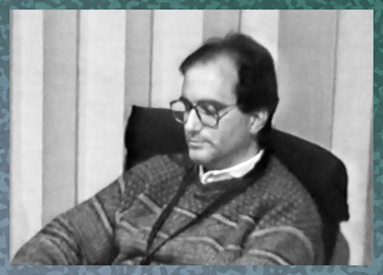 Though Jim originally labeled this chord as Dmaj7/Bb, most of the time, you would see such a chord labeled only as D/Bb or Bbmaj7#5 - but, having that C#/Db present means that you have both the major and minor 3rds in the chord - and usually that can cause problems for the soloist. Also, I tried to listen to it as D/Bb, but even when I did that, the note F# sounded completely wrong to me - so labeling the chord that way seems really strange to me. If you notice on the solo transcription, I have parenthetically included Jim's voicing within this bar: spelling down C#-A-D/Bb. Even though that D-natural is there, the more pronounced feeling you get is that Mike was hearing this as A/Bb. For many, the scale that they might use would be, from the root: A 1/2-tone/whole-tone diminished scale [A, Bb, C, C#, D#, E, F#, G], notice that an A triad is right there in the middle of it all - and that's what Mike consistently alludes to each time this sonority appears. Though Jim originally labeled this chord as Dmaj7/Bb, most of the time, you would see such a chord labeled only as D/Bb or Bbmaj7#5 - but, having that C#/Db present means that you have both the major and minor 3rds in the chord - and usually that can cause problems for the soloist. Also, I tried to listen to it as D/Bb, but even when I did that, the note F# sounded completely wrong to me - so labeling the chord that way seems really strange to me. If you notice on the solo transcription, I have parenthetically included Jim's voicing within this bar: spelling down C#-A-D/Bb. Even though that D-natural is there, the more pronounced feeling you get is that Mike was hearing this as A/Bb. For many, the scale that they might use would be, from the root: A 1/2-tone/whole-tone diminished scale [A, Bb, C, C#, D#, E, F#, G], notice that an A triad is right there in the middle of it all - and that's what Mike consistently alludes to each time this sonority appears.NOTE - EXTRA MATERIAL: I wanted to take a moment to address the treatment of a sonority like this, A/Bb (if one chooses to hear it this way) and the usage of this particular diminished scale. Mike Brecker is certainly not averse to hearing such things - and with more time and space, he often uses the diminished scale here and there - but usually when making a transition or cadence to a major or dominant chord. He also uses it going to a minor chord which can be problematical for most players, because the diminished scale contains the note that is the major 3rd of the i-minor chord to which you are headed. So, if one placed too much emphasis on THAT note, it could sound awful. But, as Mike usually plays through this scale so rapidly, you never notice it, never hear it. Over the years, everyone has tried to make this scale sound like something other than what it is, because it gives rise to the playing of patterns. And, though interesting, one gets tired of that pretty quickly. So, exploring the "scale" in a deeper way, you find that within it, you have 4 major triads (or dominant 7th chords) and the same as minor triads (or m7th chords). Here you would have: A major (A7)/A minor(Am7); C major(C7)/C minor(Cm7); Eb major(Eb7)/Eb minor(Ebm7); Gb major(Gb7)/Gb minor(Gbm7). You can use these tools to explore this sonority - but, I don't believe that they are going to fit in the context of "Baker's Annex" because the chord just goes by too quickly. Just a thought. In bars 7-8, Jim provides Mike with one of the most tried and true walk-up chord progressions, in this case we are in Db major though the chord progression which begins on the ii chord, Ebm7 to Db/F to Gmaj7. You could view this entire moment as being in Db major, and the mode would be: Db Ionian [Db, Eb, F, Gb, Ab, Bb, C]. As it is, in essence, the Db major scale, one could be as gracefully melodic as one hears things. If you look at Mike's note choices, they are all from within that scale. This first 8-bar section closes with 2 beats of C/D, which normally I would view as being: A Dorian [A, B, C, D, E, F#, G], but Mike chooses again to take a breath here - a nice relief for what is to come. Other than the last chord in bar 12, Jim's changes are the same as in bars 1-4. Playing over these changes a 2nd time, Mike sounds even more in the flow of the piece, with his playing being so very melodic and expressive. This time when we arrive at what I have chosen to label as either A7(#9#5), or what you could call: C#/Dbmaj7#5/A, it is interesting to note that here, Mike plays, in essence, an A augmented triad (A-F-C#-A), and it sounds great to me. In discussing this very chord with Jim Beard, he said that my perception of it was fine, but he feels that soloist can it view this way, harmonically speaking, but in his view, G-naturals should be avoided. When this same chord reappears in bar 19, that A augmented triad appears again. In bar 12, Mike's approach to the Bm7(sus)/F# is the same, but the next chord has become A/B which could be viewed as: F# Dorian [F#, G#, A, B, C#, D#, E], however listening to what Mike actually played, I now view those note choices as: C# minor pentatonic [C#, E, F#, G#, B]. As he cadences to the Db7(sus) in bar 13, he does an interesting thing by playing an Fb there, which, of course, is the m3rd - you could view this as a blue-note, but, with a voicing like Gb-Cb-Db-Gb, spelling up, because it has no 3rd in it at all, one is free to define major/minor in whatever manner one chooses. This is why ambiguous sonorities like that are so wonderful, because you are granted so much freedom and latitude. In bars 13-15, there is the first long flurry of double-time notes. One passage like this could easily be more than enough to discourage me from continuing! Don't worry, it's O.K. to laugh at me. But, ever the stubborn bastard that I am, I would not let a passage like this, or those to come, completely defeat me, even if what I chose to write might not be 100% accurate. For help in this area, I have no shame about turning to Andy Robinson's brilliant program, Transcribe! a program which none other than Michael Brecker told me about many years ago. At this point, I must return to something that Michael has always said about himself, and that is that, he was more of an intuitive player rather than a schooled player. Of course, I don't know that I want to totally believe that, even if he said it repeatedly himself. As hard as he worked, all the incessant practicing, it couldn't have been all intuition that guided him through complex passages of moving harmonies - harmonies not in the chord progression, but only in his imaginative way of finding a path, perhaps a new path, from Point A to Point B. Simply put, Mike heard things, he heard them his way, and made us all believe that what was being played was coming from a deep place within his soul, his being - and yes, as it was happening, it had NOTHING to do with the intellect, or any kind of cerebral process. That aspect took place in all the endless hours of practice, jamming, playing drum duos until the sun came up, but when it is really time to play, there is no B.S.'ing around!!! Not at all - you have to hear something, and then, you have to play it!!!  For many of us, that is the essence of Michael Brecker. It is interesting that, even within this complex flurry of double-time notes, on beat 3 of bar 14, over what I have chosen to label as A/Bb, Mike also hears that same A augmented triad in the middle of all of those notes! Imagine that! As this phrase comes to a close on the downbeat of bar 16, he takes a breath, and on beat 3, over the C/D chord, he's descending down the A Dorian mode leading into bar 17 and the beginning of what we will now refer to as [Chorus 2]. For many of us, that is the essence of Michael Brecker. It is interesting that, even within this complex flurry of double-time notes, on beat 3 of bar 14, over what I have chosen to label as A/Bb, Mike also hears that same A augmented triad in the middle of all of those notes! Imagine that! As this phrase comes to a close on the downbeat of bar 16, he takes a breath, and on beat 3, over the C/D chord, he's descending down the A Dorian mode leading into bar 17 and the beginning of what we will now refer to as [Chorus 2].As I initially stated, the solo format is 16 bars, and we could have called the 1st 16 as [Chorus 1]. So as Mike arrives at Bar 17, to my way of thinking, he is beginning [Chorus 2]. If you recall from the prior chorus and its bar 1, here Mike begins with a grouping 6 where in his style, he is surrounding a main chordal or modal tone (Ab) with a chromatic upper neighbor (A-natural) and a consonant lower neighbor (Gb) over the Db7(sus) chord. But, again it is most interesting that when he goes up in register, he hits an Fb - which is really a blue note for this chord. Mike has already employed that note over this same chord in bar 13. Here, over the Abmaj7(6) chord, he focuses on the color tones of F(6th) and Bb(9th), and on beat 4 he even plays an F-triad, yes - with an A-natural in it. It is simply his great instinct for hearing harmony that his intuitive target note on beat 1 of bar 18 is a Bb. Bars 18-19 are filled with 16th-notes - and even though 16th-notes might appear to be double-time at this tempo and harmonic rhythm (the changes appearing every 2 beats), if the piece had been written out in cut-time, these same notes would just become swingin' 8th-notes. As Gbm9 arrives in bar 18, he plays some really interesting notes, again featuring chromatic neighbors. Firstly he plays a Bb on the downbeat - that would be the maj3rd of Gbm9 - think about that! In the end, it all surrounds the Bbb, the m3rd, on the 4th 16th-note. If you like things like this, small details, you have to learn to HEAR things this way if you really want to make your own playing believable. On the last two beats of this bar, over the Ebm7sus/Bb, he is ascending by using Eb minor pentatonic [Eb, Gb, Ab, Bb, Db]. Notice that the first 4-note grouping begins on Bb, and the second begins on Eb. In bar 19, over the Bbm7sus/F, he plays a linear configuration derived from Bb Dorian, but as the A7(#9#5) arrives on beat 3, you again hear him gravitating to the A augmented triad (C#-A-F). It is an often overlooked detail, small but important, little triads like this appear constantly throughout the Bebop language of Charlie Parker! So, this is not "new under the sun." In bar 20, Mike closes out the long phrase with a simple grouping of 4 16th-notes over Bm7sus/F# coming from B minor pentatonic [B, D, E, F#, A]. Once again, on beat 3 of this closing bar, he takes a breath and leaves some space - because a monster double-time flurry is coming! Bars 21-22 are mirror images of bars 5-6. Over the Db7sus, Mike is really using Db minor pentatonic [Db, Fb, Gb, Ab, Cb], and NOT Ab minor pentatonic, you have to remember that, if you can hear things this way, even if the chord is a dominant 7th chord - though no 3rd appears in Jim's voicing - you can just as easily put to use that blue note (Fb) and it will sound fine. As Mike is now headed towards the Dm7sus/A chord, his pentatonic line goes up a 1/2-step in anticipation of the coming chord. Then, on beat 3, Mike again employs the kind of neighboring chromaticism, here surrounding the root of D-natural. As I pointed out previously, D Dorian and F Lydian (for the Fmaj7#4 chord) have the same notes, 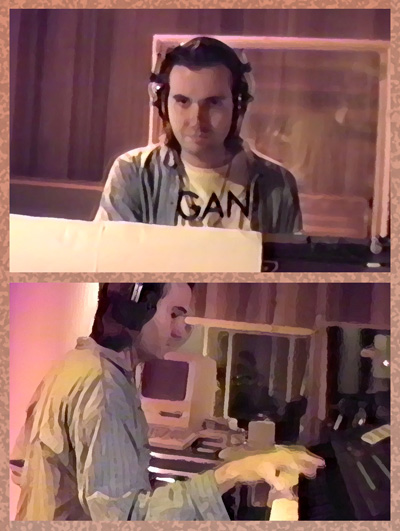 so you can see that from beat 4 of bar 21 through the first 2 beats of bar 22, there are no accidentals, so it is all scale or modal tones. On beat 3 of this same bar, Mike takes a slightly different route, over what I have chosen to label as A/Bb - and again, I have to point out that the time gets a bit blurry here with the density of the notes - but Mike begins this grouping of 7-notes with C-D-E, but as the E turns to F#-G-A-B - that's right up E Dorian. In the end, the target note is that high C#. Remember how he has been spelling out the A-triad in the past. But here? After that A-triad, a lower Bb appears before reascending via our A-triad. From that same high C#, he slurs down a 1/2-step, and lands on a C-natural as the Ebm7 chord appears. Again, you could say that this whole 5-beat passage over Ebm7-Db/F-Gbmaj7 is all very diatonic and could be viewed as the Db major scale or Eb Dorian - both have the same notes and will sound completely melodic over these chord changes. so you can see that from beat 4 of bar 21 through the first 2 beats of bar 22, there are no accidentals, so it is all scale or modal tones. On beat 3 of this same bar, Mike takes a slightly different route, over what I have chosen to label as A/Bb - and again, I have to point out that the time gets a bit blurry here with the density of the notes - but Mike begins this grouping of 7-notes with C-D-E, but as the E turns to F#-G-A-B - that's right up E Dorian. In the end, the target note is that high C#. Remember how he has been spelling out the A-triad in the past. But here? After that A-triad, a lower Bb appears before reascending via our A-triad. From that same high C#, he slurs down a 1/2-step, and lands on a C-natural as the Ebm7 chord appears. Again, you could say that this whole 5-beat passage over Ebm7-Db/F-Gbmaj7 is all very diatonic and could be viewed as the Db major scale or Eb Dorian - both have the same notes and will sound completely melodic over these chord changes.Even though Mike is about to hit bar 25, it is crucial that we look at what he plays over the C/D chord on the last 2 beats of bar 24. What's going on here is that Mike is ignoring the C/D chord and anticipating the chord to where he is headed, Db7sus by playing, once again, Db minor pentatonic - and you see/hear the blue note of Fb. In bar 25, he is leaning on Ab and Cb, two of the important notes in that same pentatonic and very consonant with the Ab Dorian mode. On beat 3, as the Abmaj7(6) chord arrives, he plays Bb to G-natural (the maj7th), but the G-natural is actually a multiphonic, and you hear the octave above just as much as you hear the actual lower note. In bar 26, while really laying back his phrasing, Mike hits another multiphonic, this time it's a Gb in the middle of the triplet on beat 2. Here the precise nature of the rhythmic content gets blurred, so you can't really view how I've notated it too strictly. In bar 27, he vaults up to a high F-natural, and nicely descends through Bb Dorian over the Bbm7sus/F. But notice on beat 3, as the A7(#9#5) arrives, he descends from C-natural through Bb to an A-natural - and those 3 notes can be easily found in the previously mentioned A altered dominant scale. Even though A-natural is the root of the chord, in this case, it makes for a really great resolution coming from a modal area where Ab's would be common. In bar 28, as the chord now becomes Bm7sus/F#, Mike is in B Dorian, with a touch of descending Jazz chromaticism F#-F-E before landing on a real 'chord defining' interval of the 3rd (D#) against A/B, which is basically a B7 sonority. All the notes that he plays could viewed as being part of F# Dorian, but they have a decidedly B7 kind of feeling to them - especially because of the configuration of the notes. On beat 4, he plays G#-F#-C#-B which becomes a perfect transition to the Db7sus on the downbeat of bar 29. Mike plays the exact notes that appear in Jim Beard's keyboard voicing, spelling down: Gb-Db-Cb-Gb. It is important to note that Gb(F#) and Cb(B-natural) appear in the beat before. This becomes a perfect example of hearing through the changes. Common tones! On beat 3 of bar 29, with the Dm7sus/A, Mike is back playing chord tones, all from Dm7 or D Dorian, and this approach continues through the Fmaj7#4 chord for the first 2 beats of bar 30. On beat 3, the A/Bb sonority reappears, and yet again, and I know that I'm repeating myself but, as Mike has ascended to a C#, he comes down using an A major triad. Then, on beat 4, he does what most seasoned players might do, he anticipates the arrival of Ebm7 by simply playing Bb-Eb-Gb-Bb. As Mike closes out this fantastic solo, in bar 31 he plays a line configuration that is probably filled with the most Jazz-oriented chromaticism of this solo, as he vaults up an Ebm9 arpeggio up to a high F-natural and then descends with chromaticism from F-E-Eb and later Ab-G-Gb - all of these notes are within Eb Dorian - but remember, you could easily view these three chords: Ebm7-F/Db-Gbmaj7 as being in the key of Db. In bar 32, he continues descending through a Db triad. Even though, on beat 3, the C/D chord has arrived - Mike doesn't really acknowledge it until beat 4 when he finally lands on his low A-natural. A great conclusion. I would say that this solo has a denouement as Mike continues to play lightly over a reprise of [I], the Intro. Even though contrabass guitarist Anthony Jackson is tacit in these 4 bars, there is always the sense that there could have been some kind of Db pedal under the four chords. So, the first chord is the now familiar Db7sus voicing, and over this sonority he plays an arpeggio Eb-Gb-Bb-Db, which on the surface appears to be Ebm7, but if you view those tones as they relate to being the extensions of Db7 or Abm7/Db, you have: Eb(5th)-Gb(7th)-Bb(9th)-Db(sus4) - lots of color tones. Then, on beat 2, he vaults right up an Abm9 arpeggio to a high Db, and descends slowly into the next chord. This chord with only 3 notes: F-Bb-Ab could be part of any number of chords. But, within the very R&B orientation of the bass line's phrase ends on a Bb, so one has to see this chord as Bbm7 - and if you added a nice Eb below the Ab (easy to do on the guitar too), you would have the sus4 in there as well. All the notes that Mike plays in that bar speak of Bb minor as the relative minor to Db major. That is why Mike hears that Gb in passing. Then in bar 3, you have an Eb minor triad, and that could be seen in a variety of ways too. But I still see it as the iim chord in Db major, and look what Mike plays there. He essentially plays notes from Eb minor pentatonic, but those same notes are in Db major as well. The last chord is an Eb major triad. And, if it was over an implied Db, in this context I see it as Dbmaj9(#11). Notice his pick-up note is a G-natural to a Bb(6th), an F(3rd) and finally an Eb(9th). All four bars are performed softly and sensitively, and Jim Beards's fantastic composition is headed home! If you will allow me, I would like to revisit where this all started and that was returning to listen to Jim Beard's Intro for "Baker's Annex." I was struck by Jim's wonderful choice of a synth melodic voice, the sparse nature of what he played over the insistent quarter-note pulse. You can never underestimate the impact of a pulse or groove like that because it even inspires average people to tap their foot - and engaging your potential audience like that is a big thing. After transcribing the form, 16 bars, and the chords - as I heard them - I was fascinated by Jim's note choices. In essence, he's just playing two notes per bar. When he plays Bb to Eb in bar 1, he has heard two notes that are not chord tones within the voicing. To me, right away, that's a great thing. Then the interval stays the same, a 5th, but is inverted and a whole-step lower. Then, in bar 3, the notes go down while still remaining as a 5th. What is going on here is really a classic musical device, no matter what the genre might be. It is simply thematic development. I believe that intellectually we would all want our solos, at the very least, to begin this way. And here, Jim has done it perfectly. Then in bar 7, for me, he plays a really beautiful note, an E-natural (though I believe that I should have written it as an Fb). What is that note and why is it so striking? Of course, my philosophy over the years is: if and when a note seems to be out of the ordinary, that note doesn't sound good for no reason. It has to make some harmonic sense - somewhere. So, as I see this, E-natural(Fb) this a blue note from the Db blues scale [Db, Fb, (F), Gb, G, Ab, Cb]. Why Db when the bass hasn't entered yet? This is because I felt that I heard Db as the best pedal note over all of the chords. Yes, when Anthony Jackson' bass enters his figure does seem to center around Db even though its last note is a Bb. So, to me, this is why, on some theoretical level, that E-natural/Fb sounds so good. As Jim's brief improvisation moves through the next 8 bars, the activity increases a bit and then returns to the sense of the first 4 bars to conclude, leading us perfectly into the [A] melody. It's all beautifully done, and it was this little section that caused me to listen to Michael Brecker's solo again, after some years had passed - and I felt the desire to somehow try to transcribe it. And, here we now are. The amount of respect and admiration that I have for Jim Beard as a composer should be most obvious by now. I don't believe that there is a much greater tribute the body of work of any composer than to see a collection of his/her songs arranged and orchestrated by someone like Vince Mendoza and then performed by the Netherlands' superb Metropole Orchestra. 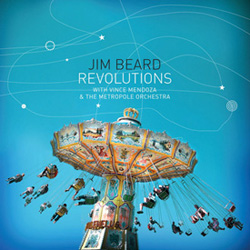 In this case that combination of talents resulted in the album, "REVOLUTIONS"(Intuition). The selected songs came from Jim's albums that included: "SONG OF THE SUN"(1990); "LOST AT THE CARNIVAL"(1995);" TRULY"(1997); and "ADVOCATE"(1999). If you investigate and explore the original recordings of each of these songs, you will find that, contained within is Jim Beard's great sense of orchestration on his own - often putting to use woodwind sounds and textures that add to the feeling of the piece of music. This element alone made Vince Mendoza's task that much easier. Sadly, for me, "Baker's Annex" was not included. Jim did tell me that it was "on the list" but it just didn't make the final cut. In this case that combination of talents resulted in the album, "REVOLUTIONS"(Intuition). The selected songs came from Jim's albums that included: "SONG OF THE SUN"(1990); "LOST AT THE CARNIVAL"(1995);" TRULY"(1997); and "ADVOCATE"(1999). If you investigate and explore the original recordings of each of these songs, you will find that, contained within is Jim Beard's great sense of orchestration on his own - often putting to use woodwind sounds and textures that add to the feeling of the piece of music. This element alone made Vince Mendoza's task that much easier. Sadly, for me, "Baker's Annex" was not included. Jim did tell me that it was "on the list" but it just didn't make the final cut.As much as Jim Beard is a unique and imaginative composer, he is a great texturalist. Each song comes to life within the setting of a "mood" and that is presented with plenty of "attitude" - two elements that are essential for me, as a listener, as a fan, in any and all truly great music. Jim seems to have an unending palette of keyboard sounds that create highly stylized atmospheres that always seem to best suit the players that he selects to perform them. The supporting cast on Jim's albums is usually varied, but always with a sense of purpose and direction. I would urge you all to invest in Jim's albums and the glorious interpretations of his music on "REVOLUTIONS." I have supplied the links for both Amazon and Apple music, you only have to click on the links and you're there. Go for it! I believe that I met Jim Beard during the mid-'80s on some gigs with saxophonist Bill Evans. If my memory serves me well, bassist Mark Egan and drummer Billy Ward were there too. Though it was, in a sense, a brief encounter, we all had a lot of fun together and enjoyed playing the music together as well. I can't be certain but the next time that I was really working closely with Jim was during the two albums that I produced for guitarist Mike Stern, those being "TIME IN PLACE" and "JIGSAW."  It was during those two albums that my appreciation for Jim as keyboard artist, arranger and player deepened and has only grown exponentially since. The photo that I am sharing here was actually extracted from a brief video of the session for "TIME IN PLACE" filmed by Peter Erskine's dear father. Of course, Mike Brecker was there on that particular day too. And the photo above of Mike, was from a moment when he was listening to a playback of "Chromazone." And by the way, the original title of that tune was to have been, "Chromatose" - which everyone really loved - but Mike Stern was uncomfortable with it. It was during those two albums that my appreciation for Jim as keyboard artist, arranger and player deepened and has only grown exponentially since. The photo that I am sharing here was actually extracted from a brief video of the session for "TIME IN PLACE" filmed by Peter Erskine's dear father. Of course, Mike Brecker was there on that particular day too. And the photo above of Mike, was from a moment when he was listening to a playback of "Chromazone." And by the way, the original title of that tune was to have been, "Chromatose" - which everyone really loved - but Mike Stern was uncomfortable with it.Jim and I, in our way, have been good friends ever since those days, though in truth our paths rarely cross - musically or personally - yet a great deal of warmth and mutual respect is always there. Our personal lives have taken some tumultuous turns and Jim's fantastic career has taken him far and wide in his travels - and, of course, as a composer and producer, his productions for any number of great Jazz artists has just grown and grown. I just love his body of work. And so, here I am finally paying some kind of direct tribute to him and all that he has done - in this case, encapsulated in this Michael Brecker solo on "Baker's Annex" from Jim's "SONG OF THE SUN" album, his first album as a leader. As for Mike Brecker? Like many of us, I miss him personally every day. Lucky for me and for all of us, there remains so much of his recorded work to enjoy, and, of course, there are countless YouTube videos to call upon when his spiritual presence is required to make any day that much better, richer. Though I have written this before, in the end, Mike heard things, magical things, in his musical imagination, and he played those things as only he could - including all the influences, and all influences aside. I listen to what he has left behind for all of us, and I still shake my head in utter amazement that this once in a generation type of musician could have been my friend and my bandmate. He is never forgotten by me, nor anyone who felt these same things. As we prepare to say "Goodbye!" to 2022, we are hoping that everyone has a very MERRY CHRISTMAS and a ¡FELIZ NAVIDAD! And, of course, now it is time to finally say, yet again, HAPPY NEW YEAR!!! Y por supuesto, les deseamos un muy ¡FELIZ AÑO NUEVO! Wishing you all good health, happiness, and please, PEACE everywhere!!! Personally speaking, I have absolutely no idea what to expect from 2023 and beyond. Thanks again for your wonderful messages via the CONTACT STEVE page, as well as the supportive comments that appear in our GUESTBOOK.
[Photos: Jim Beard by Bastian Reuter/PHNM(Germany)
Michael Brecker Digital Portrait by Handelian Michael Brecker Listening to a Playback by Dr. Fred Erskine Jim Beard Collage, Photos by: Dr. Fred Erskine; Collage by Steve Khan Jim Beard and Steve Khan @ Skyline Studios ca. 1987 by Dr. Fred Erskine] |